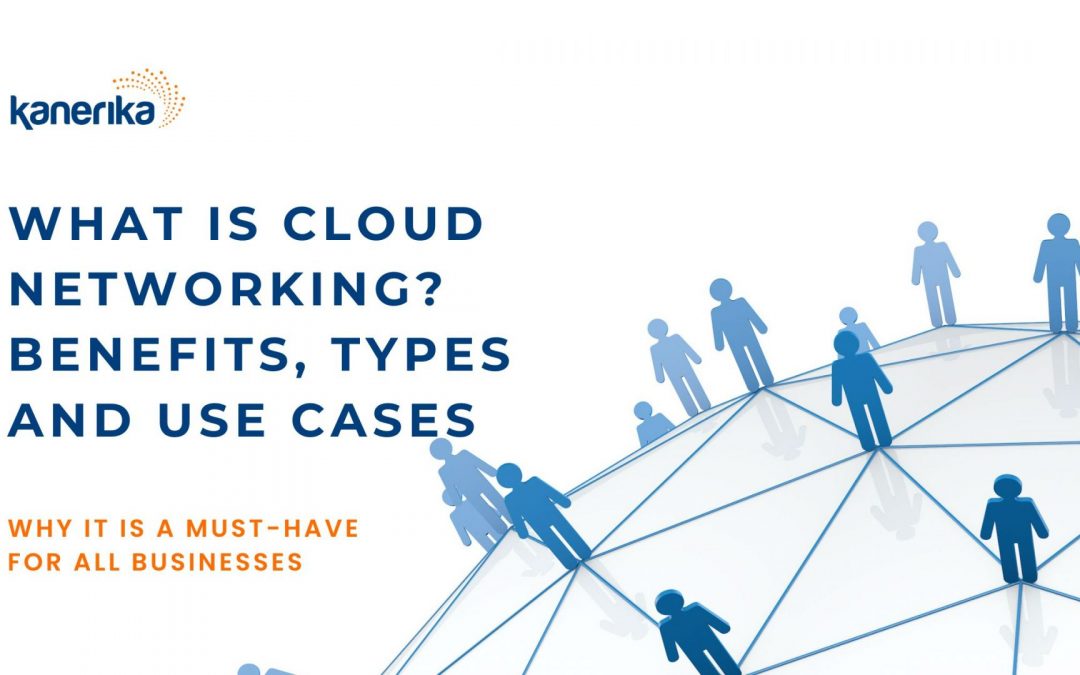Cloud networking and computing technologies have transformed business operations since their inception.
What started out as the first cloud framework in 2022 through Amazon Web Services has today grown into a multi-billion dollar industry that’s fueling the modern economy.
This is evident in Marc Benioff’s famous quote, “The cloud services companies of all sizes…The cloud is for everyone. The cloud is a democracy.”
Before this cloud revolution, enterprises used to build and maintain their own servers, storage, load balancers, and routers. This meant companies had to invest a substantial amount of capital in building and maintaining their data and servers.
By the turn of the millennium, broadband had gradually become available, allowing local clients to access data when necessary and store it remotely.
The cloud model has become so popular now that it is now a $500 billion industry and growing at 10% CAGR – a massive figure!
In this article, we will talk about what is cloud networking and why it’s a must-have for businesses of all sizes.
Table of Content
- What is Cloud Networking?
- Why do Businesses Use Cloud Computing?
- Understanding Cloud Networking vs Cloud Computing
- How does Cloud Networking Work?
- What are the Types of Cloud Networks?
- Benefits of Cloud Networking for Businesses
- Cloud Networking Use Cases Across Industries
- Cloud Networking Trends in 2024
- Kanerika: Your Trusted Cloud Services Partner
- FAQs
What is Cloud Networking?
Cloud networking refers to connecting and managing your network resources using cloud-based services instead of traditional on-premises hardware.
The model replaces physical networks with virtual ones that run on a sizable, secure network infrastructure that a cloud provider provides. The biggest providers of cloud networking solutions are Google Cloud, Microsoft Azure, and AWS.
Virtual routers, switches, load balancers, firewalls, bandwidth, network management, and other resources are among those available. Cloud networking offers self-service tools and automation for simpler configuration.
Why do Businesses Use Cloud Computing?
Businesses require cloud networking solutions for enhanced connectivity and to facilitate seamless interaction among applications and workloads across diverse environments. These include cloud services, on-premises data centers, and edge networks.
This approach is crucial for optimizing performance, ensuring robust security, and efficiently managing hybrid cloud and multi-cloud environments.
The strategic design and maintenance of a cloud network plays a vital role in enabling agility, high performance, and operational efficiency.
Achieving these objectives needs collaborative efforts across various IT operations teams, including computing infrastructure, networking, and security.
Read More – Cloud Connectors: Simplifying Integration in the Cloud Era
Read More – Databricks Vs Snowflake: Choosing Your Cloud Data Partner
Understanding Cloud Networking vs Cloud Computing
Cloud networking and cloud computing are closely related but distinct concepts within the cloud framework. Let’s break them down and understand the differences in cloud networking vs cloud computing :
What is Cloud Networking?
Cloud networking is like the internet superhighway for the cloud. It’s the system that connects all the computers, servers, and devices in the cloud so they can communicate and share information.
It’s essential for smooth and reliable communication between servers, making sure everything works together seamlessly.
What is Cloud Computing?
Cloud computing is a model that consists of using the internet to access and manage software, storage, and processing power without investing in hardware. It’s like renting computing resources on the internet instead of owning and maintaining them yourself.
Cloud computing is a game-changer because it allows the use of powerful computing resources without the hassle of infrastructure.
In brief, cloud networking is a subset of cloud computing. Cloud computing and storage are the other two elements of cloud computing.

How does Cloud Networking Work?
The inner workings of cloud computing networks are complex. Cloud networking works by establishing a well-organized and secure infrastructure that allows data to flow seamlessly between different components.
There are three key parts:
Virtualized Network Infrastructure
Imagine a vast, global network infrastructure made up of physical servers, routers, and switches. In cloud networking, this physical infrastructure is virtualized. This means software creates virtual versions of these components that your cloud resources can use.
To make it very simple, it is akin to virtual machines through VMware on your desktop.
Cloud networking solutions use the same concept.
Connectivity and Communication
Your virtual network connects to the cloud provider’s physical infrastructure through dedicated connections called Virtual Private Clouds (VPCs).
These VPCs isolate your virtual network from other customers’ resources, ensuring cloud networking security and privacy.
Within your VPC, virtual routers direct data traffic between different virtual machines, applications, and storage resources.
Management and Control
You manage your cloud network through a web-based portal or API provided by your cloud provider. This portal allows you to:
- Configure network settings like IP addresses, subnets, and routes.
- Create and manage cloud networking security groups to control access to your network resources.
- Monitor network performance and troubleshoot issues.
- Automate network tasks for increased efficiency.
What are the Types of Cloud Networks?

In the last 20 years, several models of cloud computing networks have emerged. Let’s explore the primary types of cloud networks::
Public Cloud Networks
These are shared computing resources and network infrastructure offered by cloud providers like AWS, Azure, or Google Cloud Platform.
Benefits:
- Cost-effective: Pay-as-you-go pricing makes it affordable for small businesses and startups.
- Highly Scalable: Easily adjust resources up or down to meet changing needs.
- Global Reach: Access resources from anywhere with an internet connection.
Drawbacks:
- Security Concerns: Shared resources might not be suitable for sensitive data.
- Limited Control: Less control over the underlying infrastructure compared to private and hybrid options.
Private Cloud Networks
They are dedicated cloud network infrastructure for a single organization, hosted either on-premises or by a cloud provider.
Benefits:
- Enhanced Security: Complete control over the security and privacy of data.
- Customization: Tailor the network to specific needs and requirements.
- Predictable Performance: Dedicated resources ensure consistent performance.
Drawbacks:
- Higher Cost: Requires upfront investment in infrastructure or managed services.
- Less Scalability: Scaling can be slower or more complex compared to a public cloud.
- Management Burden: Requires dedicated IT expertise to manage the network.
Hybrid Cloud Networks
They combine public and private cloud resources into a single, unified environment.
Benefits:
- Flexibility: Leverage the agility of the public cloud for certain workloads while maintaining a secure private cloud for sensitive data.
- Cost Optimization: Utilize the cost-effectiveness of the public cloud for appropriate tasks while keeping critical data secure in a private cloud.
- Enhanced Scalability: Combine the scalability of the public cloud with the dedicated resources of the private cloud.
Drawbacks:
- Complexity: Requires careful planning and integration to manage both environments effectively.
- Security Challenges: Ensuring seamless and secure communication between public and private clouds can be complex.
Community Cloud Networks
These cloud networks have shared cloud infrastructure and network resources between organizations with common interests, compliance requirements, or security needs.
Benefits:
- Cost-Efficiency: Sharing resources among several organizations reduces individual costs compared to private clouds.
- Enhanced Security: Leveraging shared expertise and industry-specific security standards for common threats.
- Compliance Adherence: Streamlined compliance for regulated industries through pre-configured and vetted environments.
- Collaboration Advantages: Fosters collaboration and knowledge sharing within the community.
Drawbacks:
- Limited Customization: Less control over the infrastructure compared to private cloud options.
- Potential Vendor Lock-in: Dependence on the specific community cloud provider and its offerings.
- Finding the Right Community: Identifying the right community that aligns with your needs can be challenging.
Benefits of Cloud Networking for Businesses

Cloud networking provides a modern, efficient, and secure way to manage network resources. There are several compelling reasons why businesses of all sizes are shifting toward cloud networking:
Better Security
Cloud providers offer robust security features and expertise, often exceeding what most businesses can implement on-premises.
This includes features like advanced firewalls, intrusion detection, and data encryption.
Significant Cost Savings
Businesses only pay for the resources they use, eliminating the need for upfront investments in expensive hardware.
It is essentially a rental. There is no need to account for depreciation and running costs. If you need more, just change the settings on the dashboard, and it will be available.
More Efficient Network Management
Managing a cloud computing network involves fewer physical devices and simpler configurations compared to on-premises setups.
Servers and routers are expensive. They occupy huge space and require air conditioning. Trained IT staff is needed for managing routers and load balancing. None of that exists with cloud networking.
Increase in Business Scalability
Businesses can easily scale their cloud network resources up or down on demand to accommodate seasonal peaks, sudden growth, or project requirements.
There is no need for over-provisioning hardware or scrambling for resources during busy periods.
Improved Maintenance and Monitoring
Cloud networks are often geographically distributed and redundant. This ensures high availability and faster recovery times in case of outages or disasters.
It also takes away the headache of creating a daily backup.
Cloud Networking Use Cases Across Industries
The cloud network model has become so popular that it is now a de facto way to approach enterprise computing and networking.
How does cloud networking contribute to various sectors? We take a detailed look at different use cases:
Healthcare
A revolution in healthcare delivery is underway, thanks to the cloud.
Cloud-based platforms facilitate telemedicine consultations. This expands access to specialists, empowering remote patient monitoring for proactive intervention. Seamless data sharing helps improve diagnosis and treatment plans.
Outcome: Enhanced patient satisfaction, cost reduction through early intervention, and improved healthcare service delivery in under-served areas.
Retail
With increasing competition, the retail sector has been under siege for a decade. Cloud networking provides retailers the chance to go omni-channel.
Cloud infrastructure seamlessly integrates online and offline channels, personalizing recommendations based on customer data and powering efficient order fulfillment systems for rapid delivery.
Outcome: The outcome of our efforts will be an increase in customer satisfaction as a result of personalized experiences, optimized inventory management, and improved operational efficiency.
BFSI
Rising inflation and lower real wages have acted as a dampener for the BFSI sector. To attract new clients, the sector needs the advantages of cloud computing.
Robust cloud networking security safeguards sensitive financial data, while advanced analytics predict market trends and inform strategic decisions. AI-powered tools personalize financial services and streamline operations.
Outcome: Enhanced security and compliance, data-driven decision-making for competitive advantage, and improved customer service through personalized offerings.
Manufacturing
What a decade it has been for manufacturing! Global giants like GE and Boeing have become mere shells of what they were. Tesla overtook the market cap of GM, Toyota, and Ford combined. And then BYD overtook Tesla in global market share.
Using new technology wherever possible is crucial to staying ahead. Cloud networking makes it possible to deploy connected machines.
This optimizes production processes based on real-time data. Predictive maintenance prevents downtime, and collaborative robots enhance production flexibility.
Outcome: Increased operational efficiency and productivity, reduced maintenance costs, and improved product quality through real-time process control.
Logistics and Supply Chain
Globalization has spread out the production process. It has also made it infinitely harder to get everything where it needs to be and when it needs to be.
Cloud-based platforms orchestrate seamless logistics through real-time shipment tracking, automated warehouse operations, and data-driven route optimization.
Outcome: Enhanced supply chain visibility and transparency, optimized logistics workflows, and improved on-time delivery rates.
Startups
Cloud networking levels the playing field for newcomers. You can start a global business with only a few thousand dollars needed to set up cloud networking on AWS.
Cloud technology eliminates upfront IT investments, and provides pay-as-you-go scalability that aligns with growth. Startups gain access to powerful resources like AI and machine learning, fostering rapid innovation and competitive advantage.
Outcome: Reduced barriers to entry, accelerated time-to-market, and the agility to compete with established players.
Cloud Networking Trends in 2024
Here are some of the most popular cloud networking trends in 2024:
Network-as-a-Service (NaaS)
There is a growing trend towards NaaS, which allows companies to access network resources like bandwidth, security, and edge computing on-demand, without the need for maintaining their infrastructure.
This shift is driven by the increasing demands of IoT, 5G, and edge workloads, and offers flexibility and cost optimization for enterprises.
Cloud Security and SASE
With cloud spending on the rise, security in cloud-first environments is becoming a priority. Secure Access Service Edge (SASE) is emerging as a solution, converging networking and security into a unified cloud-native platform.
This approach offers centralized control and reduces potential attack surfaces, crucial for securing multi-cloud landscapes.
Collaborative Cybersecurity
There’s a shift towards collaborative cybersecurity, where enterprises are increasingly sharing threat intelligence and adopting collective defense strategies.
This approach is facilitated by advancements in AI and machine learning, aiming to create a more resilient and secure digital environment.
Public Cloud Adoption
The adoption rates of public cloud platforms like Azure, AWS, and Google Cloud are evolving, with Azure slightly overtaking AWS in recent years.
This indicates a balanced market with diversified options for enterprises. Public cloud adoption is crucial for cost reduction, disaster recovery, operational scalability, and efficient resource utilization.
Growth in IaaS and Cloud Spending
Infrastructure as a Service (IaaS) is expected to see significant growth, with a projected increase in end-user spending.
This growth is part of the larger trend of increasing global spending on cloud services, driven by factors like generative AI and industry-specific cloud platforms.
Kanerika: Your Trusted Cloud Services Partner
Kanerika stands at the forefront of cloud services, offering unparalleled expertise in cloud implementation, architecture, strategy, and optimization.
Our commitment is to transform your cloud networking experience by tailoring solutions that are effective and future-proof. Kanerika’s team specializes in the following areas:
Cloud Implementation: Deploying cloud solutions that align with your business objectives, ensuring seamless integration without disrupting your existing operations.
Architectural Excellence: Designing robust cloud architecture that scales with your business, enhances performance, and assures security.
Strategic Insight: Developing comprehensive cloud strategies that optimize your resources, reduce costs, and improve overall efficiency.
Optimization Techniques: Continuously monitoring and fine-tuning your cloud environment to maintain optimal performance.
Are you ready to elevate your business with cutting-edge cloud networking solutions? Explore a partnership with Kanerika and experience a cloud transformation that drives growth and innovation.
Sign up for a free consultation today!
FAQs
What do you mean by cloud networking?
What is an example of a cloud network?
What are the four types of cloud networking?
- Public Cloud Networking: Services offered over the internet to multiple customers.
- Private Cloud Networking: Dedicated network services for a single organization.
- Hybrid Cloud Networking: A combination of public and private cloud networking.
- Community Cloud Networking: Shared infrastructure for a specific community or group.













